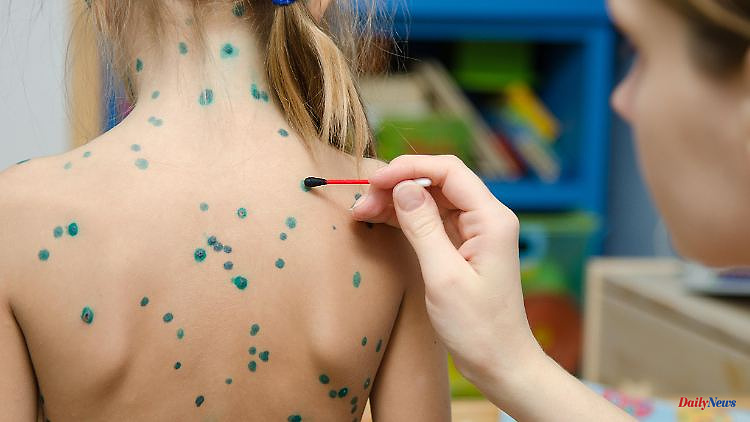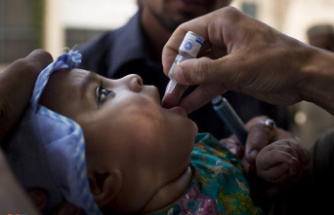Many classic childhood diseases are accompanied by spots, pustules or wheals on the skin. Each rash is slightly different - the time at which it occurs, the duration and type of symptoms differ significantly in some cases. An overview of five common diseases and the symptoms.
If the little daughter or son has a skin rash, it is often caused by a typical childhood illness. For example scarlet fever, chickenpox, ringworm, three-day fever or measles. It goes without saying that parents will then drop by the doctor's office with their child for professional assessment and treatment. But what clues can parents use for an initial assessment? An overview of five diseases:
Scarlet Fever: Does not itch and fades with pressure
In scarlet fever, the rash begins around the armpits and groin area. From there, small red spots spread over the entire body. They are the size of a grain of millet or a pinhead. Only the area around the chin and mouth is left out.
"The rash looks velvety, but it doesn't itch," says Jakob Maske, a pediatrician in Berlin. Unlike the rashes of measles or rubella, the rash of scarlet fever will fade if you press on it briefly with a wooden spatula. After one to three weeks, the rash will finally fade and the skin will peel.
"Scarlet fever is often accompanied by a sore throat and fever," says Düsseldorf pediatrician Hermann Josef Kahl. This highly contagious infectious disease is triggered by bacteria known as group A streptococci. If the child has scarlet fever, an antibiotic will be prescribed.
Chickenpox: first nodules, then blisters
Chickenpox is accompanied by a skin rash that itches uncomfortably. Blisters develop from bright red nodules that spread from the head and trunk. "They can also appear on the scalp or mucous membranes," says Hermann Josef Kahl. The vesicles are the size of lentils, are filled with liquid and burst after a few days. As it heals, crusts form and eventually fall off.
The highly infectious viral disease can show several rashes on the skin - nodules, blisters or spots at the same time. We are then talking about a so-called starry sky pattern. "A lotion that is applied to the skin helps against the sometimes tormenting itching," says Jakob Maske.
Ringworm: Like a butterfly on your face
Ringworm usually appears as a rash on both cheeks, sometimes also on the nose. The red spots are reminiscent of the shape of a butterfly. The red spots can also spread to the arms and legs. The rash is often accompanied by itching.
Later, the spots turn into pale red ringlets, which fade over time. "The viral disease is often accompanied by fever and colds," explains pediatrician Kahl. In such cases, bed rest is often the order of the day. Calf wraps or suppositories help to reduce the fever.
As a rule, the spots of ringworm do not need to be treated. "The therapy here is simply waiting," says Jakob Maske. Once the ringworm has healed, the skin needs intensive care for several weeks because it is often rough and scaly. "Oil baths and rich lotions help here," says the pediatrician.
Three-day fever: The rash comes after the fever
With this disease, the name says it all: the children first develop a high fever that lasts for up to four days before it goes away more or less abruptly. As a result, a red rash appears on the chest, abdomen and back. It can spread rapidly in a short time and also appear on the arms and legs or even on the face.
"Itching is rarely associated with the rash," says pediatrician Kahl. The rash usually subsides after about two to three days. It does not require any special treatment.
The same applies here: Antipyretics such as suppositories and lukewarm calf wraps help against the fever. Because small children in particular lose a lot of fluids due to fever, it is important that they drink as much as possible.
Measles: skin rash in the second phase of the disease
The highly contagious viral disease usually has two phases: In the first phase, patients have flu-like symptoms such as fever, runny nose, cough and sore throat. "Later, white deposits appear on the oral mucosa," says Jakob Maske. The fever rises, the oral mucosa reddens.
After a few days, the fever goes down, then the second phase begins with a rash. The fever rises again, the flu-like symptoms intensify. Small bright red spots appear on the skin. "The rash starts behind the ears and then spreads over the face to the whole body," describes Hermann Josef Kahl. The spots later turn brownish to violet and fade after seven days at the latest. The skin then flakes off.
Bed rest and rest is the therapy for measles. After consultation with a doctor, antipyretics can help against fever. The disease usually heals without any problems. However, because complications - in the form of febrile seizures, breathing difficulties or impaired consciousness - can occur, parents should take their child to the doctor if they suspect they have measles.
There is a vaccine against measles that the Standing Committee on Vaccination recommends. To be fully vaccinated, children should get their first pikes at 11 months of age. The second peak follows four weeks later at the earliest.












